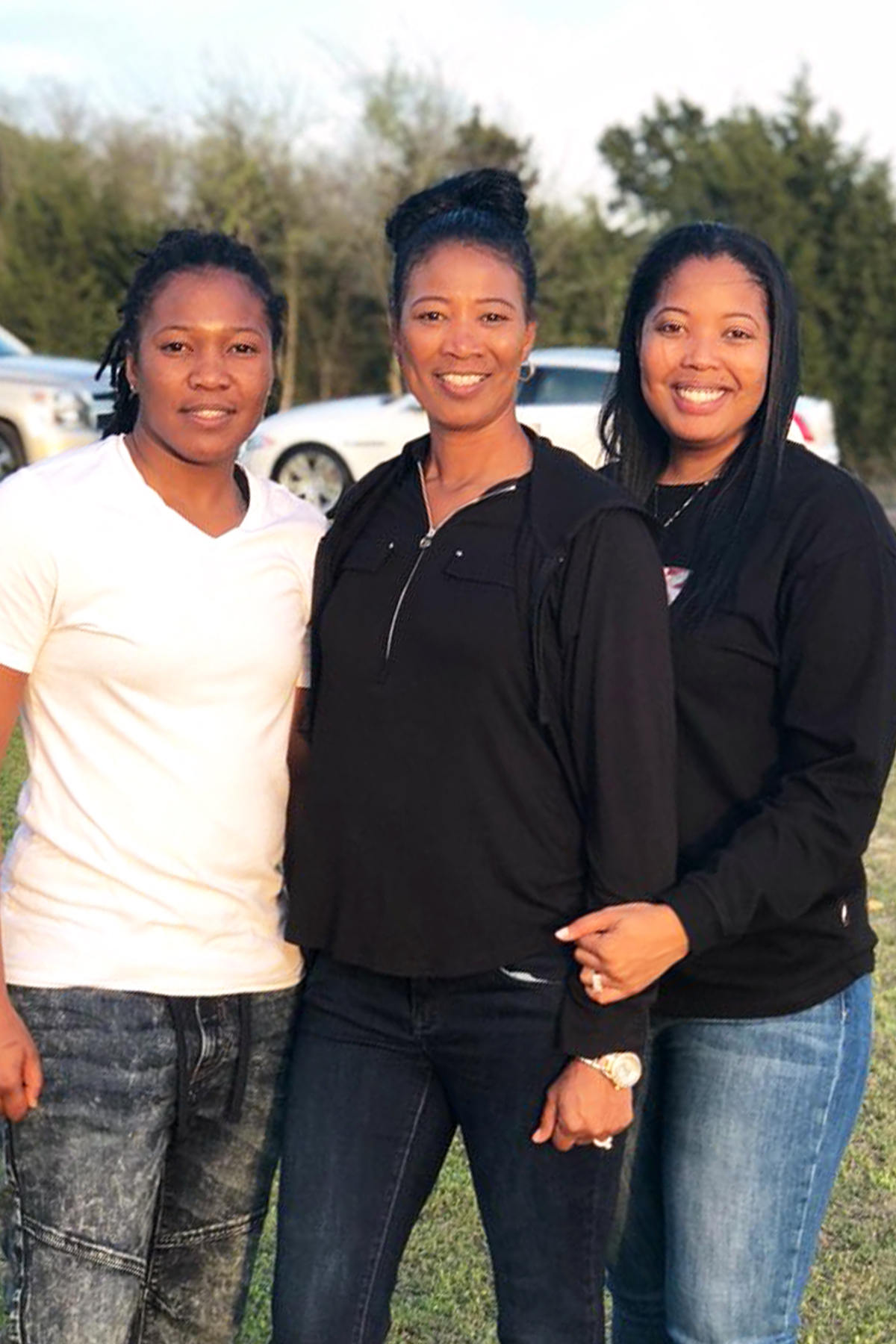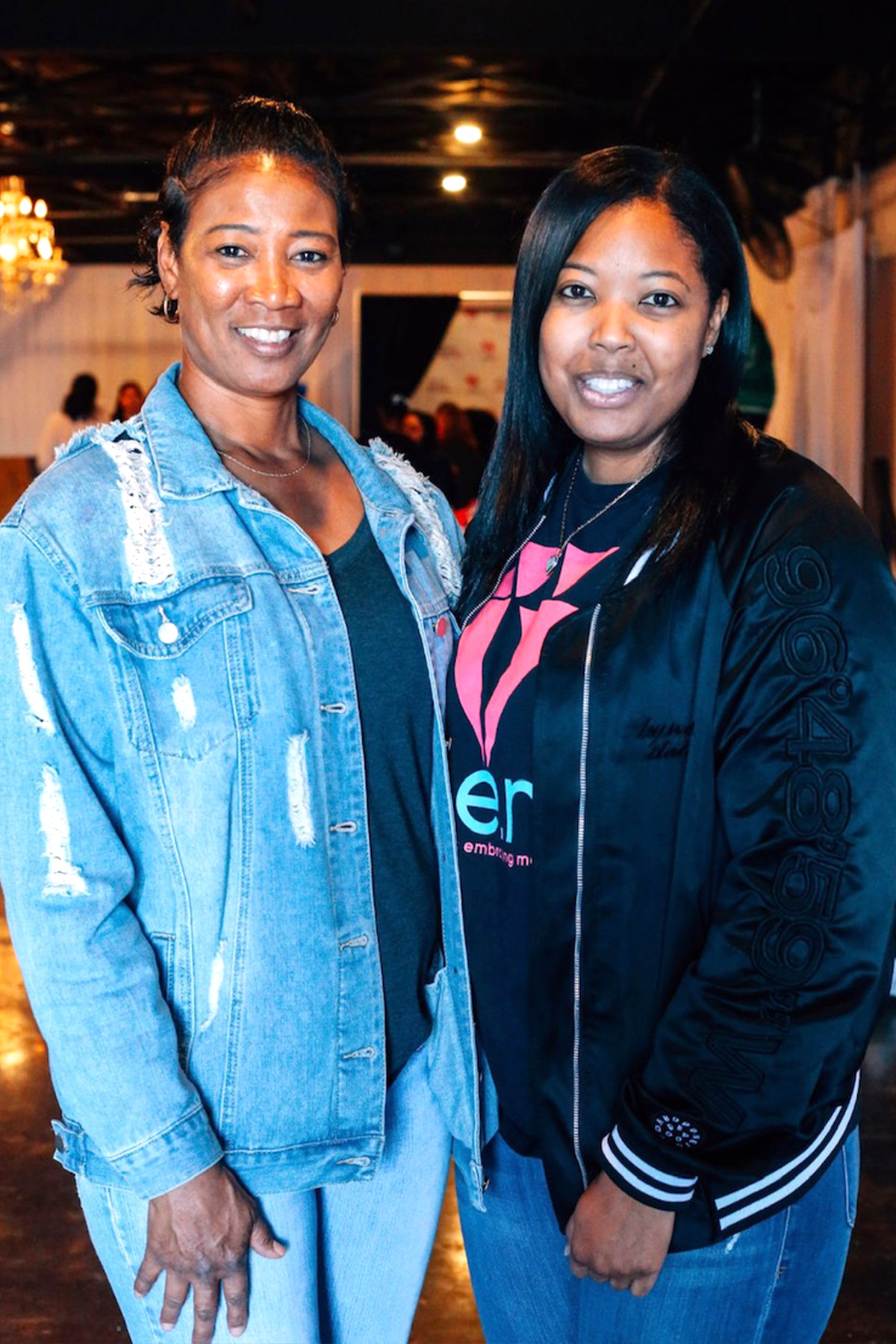On a steamy June morning, a half-dozen girls in matching black t-shirts and multicolored Crocs line up in front of archery targets set across a field in the woods. Seated behind them at picnic tables in the shade, moms and younger siblings clap and cheer as arrows pierce the concentric circles with a satisfying thwack.
Brittany Barnett is the 37-year-old founder of Girls Embracing Mothers (GEM), the nonprofit hosting this weekend camp. Today, wearing sunglasses and a t-shirt emblazoned with GEM’s hot pink diamond logo, she looks more like the preteen archers than the elegant woman in the book jacket photo for A Knock at Midnight, her well-reviewed memoir published last year by Crown; the paperback comes out August 3.
Brittany designed this mother-daughter weekend to run like any other held at Camp Whispering Cedars since the Girl Scout camp was founded almost a century ago on donated land in Southeast Dallas. Now there’s a STEM Center of Excellence, The Rees-Jones Foundation Welcome Center, and The Moody Foundation Observation Tower, but the accommodations the girls sleep in are the same cinder block cabins built in the 1950s.
The biggest difference is that these campers are being followed around by a PBS NewsHour crew from Washington, D.C., led by host Amna Nawaz in a smart twill blazer. Because all the mothers present today were once incarcerated. And the ones missing still are.
Brittany vividly recalls the first time she saw her mother in a courtroom. “There’s something about seeing your childhood hero, your guiding star, fallen. It rocks you to your core,” she writes in her book. “Add the striped Looney Tunes suit, the white judge and lawyers, my mom’s shamed expression—it’s a primal wound to see your mother like that.”
Brittany was born to teenage parents in Greenville, Texas, a city that, until the end of the 1960s, stretched a sign across its Main Street—from the bus station to the train station—proclaiming in welcome “The Blackest Land, The Whitest People.” Even so, Brittany and her younger sister, Jazz, enjoyed a mostly idyllic childhood in the country filled with homemade plum jam and plenty of love from all sides of an extended family. Grandparents and their father, a poet at heart who worked at a Dow Chemical plant, helped with childcare so their mother, Evelyn, could get a nursing degree.
After her relationship with the girls’ father didn’t work out, Evelyn married a kind man who worked long hours in a coal mine and spent his free time coaching Brittany’s basketball team. Between shifts as an aide in a nursing home, Evelyn was there for bedtime stories, morning French toast, and weekend games of Candy Land with her girls. Then, one day, Jazz found a crack pipe in her mother’s laundry.
It was the early ’90s and Nancy Reagan’s “Just Say No” campaign had been in effect for a decade. So even at 10 years of age, Brittany knew exactly what her sister held in her small hand. She also understood it was the reason behind her mother’s increasingly erratic behavior.
Within a few years, Evelyn would enter residential rehab, and Brittany and Jazz would move in with their paternal grandmother. But Evelyn wasn’t able to shake her addiction. At the time, for Black defendants—who in some Texas courts were being charged for marijuana possession 34 times more often than White defendants, despite the fact that both races use marijuana at virtually identical rates—a $10 bag of weed could get you 20 years. When Brittany was a senior in high school, her mother was arrested for the first time for a drug-induced encounter with a police officer. After she sat in jail for two months awaiting trial, she was sentenced to five years’ probation. She was released the day Brittany saw her in the courtroom, in time to accompany Brittany on her college tour of UTA.

Brittany’s father wanted her to go to the mother campus, in Austin, where Brittany was eligible to attend, having graduated well within the top 10 percent of her class. But her childhood Clair Huxtable dreams of becoming an attorney seemed far away; she decided she’d rather stay closer to home and become a bank VP.
While Brittany excelled in college, her mother kept using. Each failed drug test meant time added to her felony probation, eventually doubling it to 10 years without any additional crime. Finally, the judge had had enough and sentenced her to eight years at the Woodman Unit in Gatesville, a rural town about 40 miles west of Waco with a population of 15,000, over half of which are incarcerated in the town’s six prisons. Five of those prisons are for women.
Brittany was 22 years old when she first made the two-and-a-half-hour drive to visit her mother. On her way into the prison grounds, she drove past a field where a large man in a cowboy hat and spurs sat on a horse, an overseer of the women hoeing the soil. “Later I would learn that I’d witnessed a Hoe Squad, a common labor practice for prisoners under the age of 40 in Gatesville prisons since the 1950s,” Brittany writes in her book. “Women and men cropped all day in the fields, despite temperatures averaging 96 degrees. If a prisoner fell out of plantation rhythm, she risked being written up for an infraction.”
As she began her new routine of monthly prison visits, Brittany was starting a job in the audit group at PricewaterhouseCoopers in Dallas. But Clair Huxtable’s briefcase still beckoned. She enrolled in law school at the University of Houston, eventually transferring to SMU. For her first criminal justice paper, she didn’t have to think twice about the topic: she would write about the racial disparities in sentencing between crack and powder cocaine.
Congress enacted the Anti-Drug Abuse Act in 1986, creating mandatory minimum sentences for federal drug offenses, including a 100-to-1 ratio for powder cocaine versus crack. The bill, drafted by then Senator Joe Biden, effectively meant that possession of 1 gram of crack cocaine was equivalent to 100 grams of powder cocaine for sentencing purposes. The difference was never in the drugs themselves; crack cocaine and powder cocaine are pharmacologically identical. One is not more harmful or more addictive than the other. The difference is race. At its simplest: more White people than Black people use powder; more Black people than White people use crack. What the law did was also simple. It ensured that many more Black people went to prison for a lot fewer drugs for a heck of a lot more time.
The Fair Sentencing Act of 2010 reduced the sentencing disparity to 18 to 1, and the First Step Act of 2018 made that law retroactive. It also did away with a number of offense stacking and mandatory minimum sentencing provisions, including the federal “three strikes” law. But those provisions are not retroactive, meaning that if you got life in prison for a nonviolent drug offense due to various enhancements or prior arrests, you would still die in prison, even if it would be impossible for you to receive the same sentence for the same crime today.
For her law school paper, Brittany wanted real stories of real people to illustrate the legal arguments she was making. She found several examples of male defendants sentenced to life under federal drug laws that have since been deemed draconian, but she wanted to add a woman. She typed “woman, life sentence, drugs” into Google, and Sharanda Jones’ YouTube video popped up.
Before she was sentenced to life in prison for an offhand comment she’d made to end an unwelcome conversation, Sharanda Jones owned a hamburger stand in Terrell, Texas. She also had a hair salon and a little girl named Clenesha, whom she was raising on her own. The hair salon was doing just fine, but her real love was cooking.
She learned from her mother, Genice, who was paralyzed from the neck down in a car accident when Sharanda was 3 years old. When Sharanda got older, her mother would tell her to bring ingredients from the kitchen to her room and put them on a bedside table. She’d instruct Sharanda how to make and season the dish: a pinch of this, a dash of that. Sharanda would then take the food back to the kitchen and cook it on the stove, bringing it back to her mother for further tastings and adjustments.
Sharanda says she never did drugs herself, never had a drink or a smoke in her life. She had never been arrested or had so much as a traffic ticket. But in the past, she had helped her friends out on occasion, transporting, say, a kilo of cocaine from Houston to Dallas for $1,000 a trip. With her mom and her daughter, there were always things she needed a little extra money for. “Not over-the-top money,” she tells me, “but just enough to make all the ends meet without struggling.”
They’re not getting out for rehabilitative programming. They’re not having visits. The psychological impact of COVID on people in prison is going to far outlast the pandemic.
It was never a regular thing, and she’d already stopped by the time the DEA made a big bust in Terrell on November 17, 1997, the biggest in Kaufman County history at the time. So when her friend kept contacting her after the bust, begging to be hooked up with her supplier, she suspected something was up. She kept telling her friend, truthfully, she was out of the game, that she had no more contacts. But then, simply to put an end to the pestering, she said, “But let me see what I can do.”
The friend was wearing a wire, and soon Sharanda, Genice, and other family members were indicted on federal drug charges. Sharanda was painted by prosecutors as the kingpin who delivered duffel bags full of powder cocaine to her brother and quadriplegic mother so they could manufacture crack out of her mother’s home. It didn’t matter that no physical evidence or drugs were ever tied to Sharanda or her mother, or that Sharanda’s friend and her cohorts were the ones found with all of the implements for manufacturing crack, as well as $40,000 in cash.
A jury acquitted Sharanda of six possession charges but found her guilty of one count of conspiracy to traffic cocaine. The conspiracy law was drafted broadly, requiring nothing more than a voluntary agreement between two people to traffic any amount of drugs, no matter how large or small, to enable law enforcement to target international drug cartels. But it was more often being used as an insurmountable threat against low-level players to convince them to name names and make deals. Sharanda’s throwaway comment to her friend, without physical evidence, was enough to seal her fate.
After testifying against Sharanda, the friend and her fellow crack manufacturer served less than eight years. The wholesaler, who admitted to selling 150 kilos of powder cocaine over several years, received a sentence of 19 and a half years. Genice received a 17-year sentence; Sharanda got life. As federal defendants, they were not eligible for parole.
Sharanda was convicted in 1999. Ten years later, she received her first letter from Brittany. “She said she was a law student at SMU and she wanted to help,” Sharanda says. “I did write her a short letter back. I told her good luck with your studies, but a lot of attorneys tried to help me already. You’re a student. How you going to help me for real?”
It took Brittany six years to get Sharanda out of prison. First as a law student, reading through hundreds of pages of court transcripts, then as a young attorney in the finance and banking division at Winstead, scouring Supreme Court decisions and parsing new federal legislation in her free time to try to find grounds for an appeal. She was stymied at every turn. The allegation that Sharanda had conspired to traffic 30 kilos of cocaine—“ghost dope” that was never found—meant that even after the Fair Sentencing Act was passed, she still wasn’t eligible for a reduction in her sentence.
All the while, Brittany visited Sharanda as often as she could at the Carswell Federal Medical Center, a prison for women with special medical and mental health needs in Fort Worth. Sharanda had asked to be transferred there to be closer to her mother. The ACLU has referred to the notorious facility as a “hospital of horrors,” and that’s what it was for the paralyzed Genice, who suffered multiple broken bones from improper handling on several occasions. She ended up dying in 2012 from a staph infection after a surgery. Brittany realized she had to try anything she could or Sharanda, too, would die in prison.
A clemency petition was her Hail Mary. The president has unfettered authority under the Constitution to grant clemency for federal crimes, but there are Byzantine levels of review before such petitions arrive, if ever, on the president’s desk. Brittany was determined to try. She started Sharanda’s clemency process in January 2013, and she filed the nearly 100-page petition in November. Then came a two-year wait and a new job as in-house counsel with ORIX.
On December 18, 2015, Brittany was shopping for supplies for the GEM Christmas party. It was the last night before President Obama was leaving for Hawaii to spend the holidays with his family. That’s when she got the call. After 16 years and nine months in prison, Sharanda was free.
With her hair neatly tucked into a hairnet, Sharanda is hard at work in the camp kitchen, cooking up prison-size stainless steel trays of tacos with the help of Evelyn. Evelyn was released after serving two and a half years, and she’s been sober for 13. She got her nursing license reinstated, and she now works at the Homeward Bound addiction treatment center in Dallas. Sharanda is just waiting on the fire and health departments to greenlight her food truck, which Brittany helped finance. She’s going to call it Fed Up. She’ll serve beef and turkey burgers named after other lifers who have been freed.


After getting Sharanda out of prison, Brittany left ORIX in 2016 to dedicate herself to clemency work full-time. She became the first practitioner-in-residence at SMU’s Deason Criminal Justice Reform Center and founded the Buried Alive Project, working to obtain clemency for those sentenced to life without parole for nonviolent crimes under federal drug laws. With the help of SMU law students and volunteer attorneys from local firms such as Bell Nunnally & Martin and Jackson Walker, she has freed more than 40 people, at times leveraging relationships with celebrities like Sean Combs and Kim Kardashian to get the attention of the federal Office of the Pardon Attorney under both the Obama and Trump administrations.
Recently, Buried Alive received a $125,000 grant from the Communities Foundation of Texas to hire a full-time lawyer to help train pro bono attorneys for clemency cases. Brittany personally has six cases pending, one of which she filed in June. She founded a trucking company that employs justice-impacted drivers with a lease-to-own option so they can ultimately own their own business, and she’s pursuing venture capital to create a pathway to entrepreneurship for her clients. She has met with officials in the Biden administration to scale up the clemency process, trying to establish categorical clemency for outdated crimes. In between all that, she wrote her book. But GEM is still her baby.
With the help of two full-time staff members and 60 volunteers, in addition to the annual summer camp, she facilitates four-hour monthly prison visits for daughters and their incarcerated mothers, with packed lunches, art therapy, and structured activities. The goal is to build bonds strong enough to heal the primal wound they all share.
“It just gives me joy,” Brittany says. “I think women and girls should be at the center of any movement surrounding them, and I feel this issue of justice-impacted women and girls is just not on the radar as it should be.” Women are the fastest-growing incarcerated population, she notes, and adds that, by sheer amount, Texas incarcerates more women than any other state. (Per capita, Texas ranks 10th nationally; Idaho is
No. 1.) “Nearly 80 percent of those women are mothers,” she says.
Because Brittany understands that the impact of prison extends far beyond the mark it leaves on the incarcerated, she doesn’t simply want to reform the criminal justice system—she wants to transform it. She wants to redirect some of the $80 billion spent annually by taxpayers on the prison system to education, to mental health, to small-business grants to give people access to capital and resources in a legitimate way. She wants to reimagine what justice looks like for nonviolent offenders like Sharanda and her mother, giving them, and their children, a shot at redemption.
This story originally appeared in the August issue of D Magazine with the title, “Life on the Outside.”
Get the D Brief Newsletter
Author







